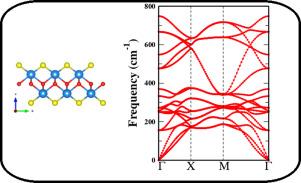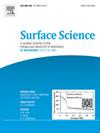HfOX单层(X = S, Se, Te):具有定制带隙和宽带光学响应的原子薄半导体
IF 1.8
4区 化学
Q3 CHEMISTRY, PHYSICAL
引用次数: 0
摘要
二维(2D)混合阴离子材料,特别是氧-硫族化合物,通过成分工程为定制电子和光学特性提供了丰富的平台。在这项工作中,我们利用密度泛函理论(DFT)与广义梯度近似(GGA)和混合BLYP泛函对铪基氧硫族化合物单层(HfOX, X = S, Se, Te)进行了全面的第一性原理研究。结构优化表明,三种单分子膜均采用四边形晶格,键长和晶格参数从S到Te呈系统增加,反映了硫依赖的空间效应。声子色散计算证实了它们的动态稳定性,电子结构分析表明hfo和HfOSe是直接带隙半导体(分别为1.08 eV和0.97 eV),而HfOTe则是间接带隙半导体(0.65 eV)。电荷密度和静电势分析强调极性共价键性质和不对称电荷分布,这对压电和介电应用至关重要。光学性质计算表明,在紫外到近红外光谱(0.6-30 eV)上具有强的宽带吸收,具有可调谐的峰和高吸收系数(>7.3×105 cm−1)。值得注意的是,HfOTe将吸收扩展到红外线,而hfo则显示出主要的紫外线活性。折射率和光电导率进一步显示出与硫有关的趋势,静态介电常数从1.82 (HfOS)增加到2.24 (HfOTe)。我们的研究结果表明,HfOX单层材料是一种很有前途的2D半导体材料,具有层相关带隙、各向异性光学响应,在柔性光电子、光伏和纳米级介电器件中具有潜在的应用前景。本文章由计算机程序翻译,如有差异,请以英文原文为准。

HfOX monolayers (X = S, Se, Te): Atomically thin semiconductors with tailored band gaps and broadband optical response
Two-dimensional (2D) mixed-anion materials, particularly oxy-chalcogenides, offer a rich platform for tailoring electronic and optical properties through compositional engineering. In this work, we present a comprehensive first-principles investigation of hafnium-based oxy-chalcogenide monolayers (HfOX, X = S, Se, Te) using density functional theory (DFT) with generalized gradient approximation (GGA) and hybrid BLYP functionals. Structural optimizations reveal that all three monolayers adopt tetragonal lattices with a systematically increasing bond length and lattice parameters from S to Te, reflecting the chalcogen-dependent steric effects. Phonon dispersion calculations confirm their dynamic stability, while electronic structure analysis shows that HfOS and HfOSe are direct band gap semiconductors (1.08 eV and 0.97 eV, respectively), whereas HfOTe exhibits an indirect gap (0.65 eV). Charge density and electrostatic potential analyses highlight the polar covalent bonding nature and asymmetric charge distribution, which are crucial for piezoelectric and dielectric applications. Optical property calculations demonstrate strong broadband absorption across the ultraviolet to near-infrared spectrum (0.6–30 eV), with tunable peaks and high absorption coefficients ( cm−1). Notably, HfOTe extends absorption into the infrared, while HfOS shows dominant UV activity. The refractive index and optical conductivity further reveal chalcogen-dependent trends, with static dielectric constants increasing from 1.82 (HfOS) to 2.24 (HfOTe). Our results establish HfOX monolayers as a promising class of 2D semiconductors with layer-dependent band gaps, anisotropic optical responses, and potential applications in flexible optoelectronics, photovoltaics, and nanoscale dielectric devices.
求助全文
通过发布文献求助,成功后即可免费获取论文全文。
去求助
来源期刊

Surface Science
化学-物理:凝聚态物理
CiteScore
3.30
自引率
5.30%
发文量
137
审稿时长
25 days
期刊介绍:
Surface Science is devoted to elucidating the fundamental aspects of chemistry and physics occurring at a wide range of surfaces and interfaces and to disseminating this knowledge fast. The journal welcomes a broad spectrum of topics, including but not limited to:
• model systems (e.g. in Ultra High Vacuum) under well-controlled reactive conditions
• nanoscale science and engineering, including manipulation of matter at the atomic/molecular scale and assembly phenomena
• reactivity of surfaces as related to various applied areas including heterogeneous catalysis, chemistry at electrified interfaces, and semiconductors functionalization
• phenomena at interfaces relevant to energy storage and conversion, and fuels production and utilization
• surface reactivity for environmental protection and pollution remediation
• interactions at surfaces of soft matter, including polymers and biomaterials.
Both experimental and theoretical work, including modeling, is within the scope of the journal. Work published in Surface Science reaches a wide readership, from chemistry and physics to biology and materials science and engineering, providing an excellent forum for cross-fertilization of ideas and broad dissemination of scientific discoveries.
 求助内容:
求助内容: 应助结果提醒方式:
应助结果提醒方式:


